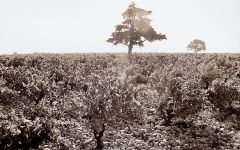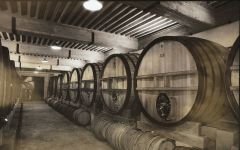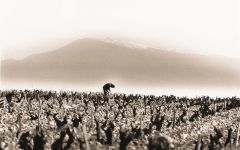Domaine du Vieux Telegraphe Chateauneuf-du-Pape La Crau (375ML half-bottle) 2019
-
James
Suckling -
Robert
Parker -
Jeb
Dunnuck



Product Details
Your Rating
Somm Note
Winemaker Notes
This classic opens with a voluptuous aroma that gives and gives—it is striking because of its charm and floral notes. How many Châteauneufs can boast of those two traits?
Professional Ratings
-
James Suckling
If anyone tells you that Châteauneuf is just a big red that’s never elegant, then they need to taste this masterpiece of elegance. So many spicy and savory nuances on the very concentrated but almost perfectly proportioned palate. This is both joyful and serious at the very long, focused finish. Decades of aging potential! Drink or hold.
-
Robert Parker's Wine Advocate
The 2019 Chateauneuf du Pape La Crau is a hugely successful vintage, marked by scents of sun-warmed stones, garrigue, black cherries and black olives. Full-bodied, rich and velvety, it finishes with tremendous length and softly dusty tannins, which should help ensure a long, positive evolution.
-
Jeb Dunnuck
The 2019 Châteauneuf Du Pape is ruby/purple-hued and has the classic translucent color of the domaine. It's more precise and focused than the Télégramme and will need more time, but it offers a complex, gorgeous bouquet of red and black fruits, crushed stone, wild fennel, and ground pepper. Pure, medium to full-bodied, and elegant, do your best to hide bottles for 5-7 years and it's going to keep for two decades.
Other Vintages
2021- Vinous
-
Wine
Spectator -
Robert
Parker -
Wine &
Spirits
-
James
Suckling - Decanter
-
Robert
Parker - Vinous
-
Wine
Spectator
-
Robert
Parker -
Wine
Spectator -
Jeb
Dunnuck -
James
Suckling -
Wine &
Spirits
-
James
Suckling -
Jeb
Dunnuck -
Wine
Spectator -
Robert
Parker
-
James
Suckling -
Jeb
Dunnuck -
Robert
Parker -
International
Wine Cellar - Decanter
-
James
Suckling -
Wine
Spectator -
Robert
Parker - Decanter
-
Wine
Spectator
-
Robert
Parker -
Wine
Spectator
-
Robert
Parker -
Wine
Spectator
-
Wine &
Spirits -
Wine
Spectator -
Robert
Parker
-
Robert
Parker -
Wine
Spectator -
Wine &
Spirits
-
Wine
Spectator -
Robert
Parker
-
Wine
Spectator -
Robert
Parker
-
Robert
Parker -
Wine
Spectator
-
Wine
Spectator -
Robert
Parker
-
Wine
Spectator -
Robert
Parker
-
Wine
Spectator
-
Wine &
Spirits -
Wine
Spectator -
Wine
Enthusiast
-
Robert
Parker
-
Wine
Spectator
-
Wine
Spectator





One cannot think of Chateauneuf-du-Pape, the most celebrated cru of the Southern Rhône, without thinking of Domaine du Vieux Télégraphe. The Brunier family is legendary in its own right, having been rooted to the enigmatic plateau known as “La Crau” for over one hundred years. The wines of Vieux Télégraphe evoke the concept of terroir in its purest form: they reflect their dramatic climate, the rough terrain that defines the soil, their full sun exposure at a higher altitude, the typicity of the varietals with an emphasis on Grenache, and of course, the influence of their caretakers, the Brunier family. For many, La Crau is Chateauneuf-du-Pape’s grandest cru.
The AOC for Chateauneuf-du-Pape is in the Rhone Valley stretching from Orange to Avignon. Domaine Vieux Telegraphe was founded in 1895, and takes it name Vieux Telegraphe (Old Telegraph) from a rocky plateau of the Domaine where in 1792 Me. Chappe, the inventor of the optical telegraph, installed a relay tower.

With bold fruit flavors and accents of sweet spice, Grenache, Syrah and Mourvèdre form the base of the classic Rhône Red Blend, while Carignan, Cinsault and Counoise often come in to play. Though they originated from France’s southern Rhône Valley, with some creative interpretation, Rhône blends have also become popular in other countries. Somm Secret—Putting their own local spin on the Rhône Red Blend, those from Priorat often include Merlot and Cabernet Sauvignon. In California, it is not uncommon to see Petite Sirah make an appearance.

Famous for its full-bodied, seductive and spicy reds with flavor and aroma characteristics reminiscent of black cherry, baked raspberry, garrigue, olive tapenade, lavender and baking spice, Châteauneuf-du-Pape is the leading sub-appellation of the southern Rhône River Valley. Large pebbles resembling river rocks, called "galets" in French, dominate most of the terrain. The stones hold heat and reflect it back up to the low-lying gobelet-trained vines. Though the galets are typical, they are not prominent in every vineyard. Chateau Rayas is the most obvious deviation with very sandy soil.
According to law, eighteen grape varieties are allowed in Châteauneuf-du-Pape and most wines are blends of some mix of these. For reds, Grenache is the star player with Mourvedre and Syrah coming typically second. Others used include Cinsault, Counoise and occasionally Muscardin, Vaccarèse, Picquepoul Noir and Terret Noir.
Only about 6-7% of wine from Châteauneuf-du-Pape is white wine. Blends and single-varietal bottlings are typically based on the soft and floral Grenache Blanc but Clairette, Bourboulenc and Roussanne are grown with some significance.
The wine of Chateauneuf-du-Pape takes its name from the relocation of the papal court to Avignon. The lore says that after moving in 1309, Pope Clément V (after whom Chateau Pape-Clément in Pessac-Léognan is named) ordered that vines were planted. But it was actually his successor, John XXII, who established the vineyards. The name however, Chateauneuf-du-Pape, translated as "the pope's new castle," didn’t really stick until the 19th century.
